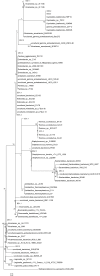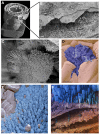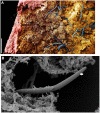Deep subsurface mine stalactites trap endemic fissure fluid Archaea, Bacteria, and Nematoda possibly originating from ancient seas
- PMID: 26441844
- PMCID: PMC4585192
- DOI: 10.3389/fmicb.2015.00833
Deep subsurface mine stalactites trap endemic fissure fluid Archaea, Bacteria, and Nematoda possibly originating from ancient seas
Abstract
Stalactites (CaCO3 and salt) from water seeps are frequently encountered in ceilings of mine tunnels whenever they intersect water-bearing faults or fractures. To determine whether stalactites could be mineralized traps for indigenous fracture water microorganisms, we analyzed stalactites collected from three different mines ranging in depth from 1.3 to 3.1 km. During sampling in Beatrix gold mine (1.4 km beneath the surface), central South Africa, CaCO3 stalactites growing on the mine tunnel ceiling were collected and observed, in two cases, to contain a living obligate brackish water/marine nematode species, Monhystrella parvella. After sterilization of the outer surface, mineral layers were physically removed from the outside to the interior, and DNA extracted. Based upon 16S and 18S rRNA gene sequencing, Archaea, Bacteria, and Eukarya in different combinations were detected for each layer. Using CT scan and electron microscopy the inner structure of CaCO3 and salt stalactites were analyzed. CaCO3 stalactites show a complex pattern of lamellae carrying bacterially precipitated mineral structures. Nematoda were clearly identified between these layers confirming that bacteria and nematodes live inside the stalactites and not only in the central straw. Salt stalactites exhibit a more uniform internal structure. Surprisingly, several Bacteria showing highest sequence identities to marine species were identified. This, together with the observation that the nematode M. parvella recovered from Beatrix gold mine stalactite can only survive in a salty environment makes the origin of the deep subsurface colonization enigmatic. The possibility of a Permian origin of fracture fluids is discussed. Our results indicate stalactites are suitable for biodiversity recovery and act as natural traps for microorganisms in the fissure water long after the water that formed the stalactite stopped flowing.
Keywords: Monhystrella parvella; diversity; stalactites; subsurface sea.
Figures





Similar articles
-
Substantial Variability of Multiple Microbial Communities Collected at Similar Acidic Mine Water Outlets.Microb Ecol. 2016 Jul;72(1):163-174. doi: 10.1007/s00248-016-0760-6. Epub 2016 Apr 8. Microb Ecol. 2016. PMID: 27059740
-
Deciphering the prokaryotic community and metabolisms in South African deep-mine biofilms through antibody microarrays and graph theory.PLoS One. 2014 Dec 22;9(12):e114180. doi: 10.1371/journal.pone.0114180. eCollection 2014. PLoS One. 2014. PMID: 25531640 Free PMC article.
-
Bacterial, Archaeal, and Eukaryotic Diversity across Distinct Microhabitats in an Acid Mine Drainage.Front Microbiol. 2017 Sep 12;8:1756. doi: 10.3389/fmicb.2017.01756. eCollection 2017. Front Microbiol. 2017. PMID: 28955322 Free PMC article.
-
Uncultured archaea in deep marine subsurface sediments: have we caught them all?ISME J. 2008 Jan;2(1):3-18. doi: 10.1038/ismej.2007.90. Epub 2007 Nov 8. ISME J. 2008. PMID: 18180743 Review.
-
Geomicrobiology of extremely acidic subsurface environments.FEMS Microbiol Ecol. 2012 Jul;81(1):2-12. doi: 10.1111/j.1574-6941.2011.01293.x. Epub 2012 Jan 18. FEMS Microbiol Ecol. 2012. PMID: 22224750 Review.
Cited by
-
Whole Genome Sequencing and Metabolomic Study of Cave Streptomyces Isolates ICC1 and ICC4.Front Microbiol. 2019 May 10;10:1020. doi: 10.3389/fmicb.2019.01020. eCollection 2019. Front Microbiol. 2019. PMID: 31134037 Free PMC article.
-
Stalactites Core Prospect as Environmental "Microbial Ark": The Actinomycetota Diversity Paradigm, First Reported from a Greek Cave.Pol J Microbiol. 2023 Jun 14;72(2):155-168. doi: 10.33073/pjm-2023-016. eCollection 2023 Jun 1. Pol J Microbiol. 2023. PMID: 37314357 Free PMC article.
-
Metataxonomic Analysis of Bacteria Entrapped in a Stalactite's Core and Their Possible Environmental Origins.Microorganisms. 2021 Nov 23;9(12):2411. doi: 10.3390/microorganisms9122411. Microorganisms. 2021. PMID: 34946013 Free PMC article.
-
New ecosystems in the deep subsurface follow the flow of water driven by geological activity.Sci Rep. 2019 Mar 1;9(1):3310. doi: 10.1038/s41598-019-39699-w. Sci Rep. 2019. PMID: 30824745 Free PMC article.
References
-
- Allan D. G., Seaman M. T., Kaletja B. (1995). The endorheic pans of South Africa, in Wetlands of South Africa, ed Cowan G. I. (Pretoria: Department of Environmental Affairs and Tourism; ), 75–110.
-
- Andrassy I. (1956). Die rauminhalts- und gewichtsbestimmung der fadenwürmer (Nematoden). Acta Zoo Hung. 2, 1–15.
-
- Borgonie G., Dierick M., Houthoofd W., Willems M., Jacobs P., Bert W. (2010). Refuge from predation, the benefit of living in an extreme acidic environment? Biol. Bull. 219, 268–276. - PubMed
LinkOut - more resources
Full Text Sources
Other Literature Sources
Molecular Biology Databases

